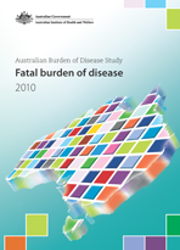Summary
Burden of disease analysis is a way to simultaneously count and compare the fatal and non-fatal impacts of different diseases and injuries. It uses information from multiple data sources to quantify the impact on a population of illness and premature death from all diseases and injuries. It uses a summary measure, the DALY (disability-adjusted life year), to describe the resulting health loss. One (1) DALY represents 1 year of healthy life lost, either through premature death or from living with an illness or injury.
The last Australian national burden of disease study was published in 2007, using 2003 data (Begg et al. 2007). An analysis of the burden of disease in Indigenous Australians was last undertaken for 2003 (Vos et al. 2007). This update of Australian estimates builds on methodological developments in recent global and country burden of disease studies, modified for the Australian context.
This report provides estimates of fatal burden for Australia for 2010; that is, the component of the DALY resulting from premature death. The results in this report are described for broad disease groups, age and sex. The full report for the current study will update and extend this report with 2011 estimates of fatal and non-fatal burden for more specific causes, and is expected to be released in the first half of 2016.
Key findings
There were around 143,500 deaths in Australia in 2010, resulting in 2.25 million years of life lost (YLL).
Cancer and other neoplasms contributed the most fatal burden, accounting for 35% of the total. This was followed by Cardiovascular diseases (23%), Injuries (13%), Neurological conditions (6%) and Respiratory diseases (5%). These 5 disease groups accounted for more than 81% of all YLL in 2010.
Males accounted for more of the burden than females for Injuries, Mental illnesses and behavioural disorders, Cardiovascular diseases and Cancer and other neoplasms. In particular, the high proportion of deaths in males due to Injuries contributed 16% of total male YLL, compared with 9% for females. Neurological conditions accounted for 6% of female YLL and 5% of male YLL.
Deaths in infants (aged under 1) contributed 5% of total YLL, but they made up only 1% of all deaths. This reflects the influence of age at death on the measure of fatal burden. The fatal burden in infants was largely due to pre-term birth complications, birth trauma and congenital defects.
Injuries accounted for the majority of fatal burden in those aged under 45, after which Cancer and other neoplasms and Cardiovascular diseases were more prominent. The relative contribution from Cancer and other neoplasms peaked around age 55-64 then declined. The Cardiovascular diseases group was the major cause of fatal burden among people aged 85 and over.



